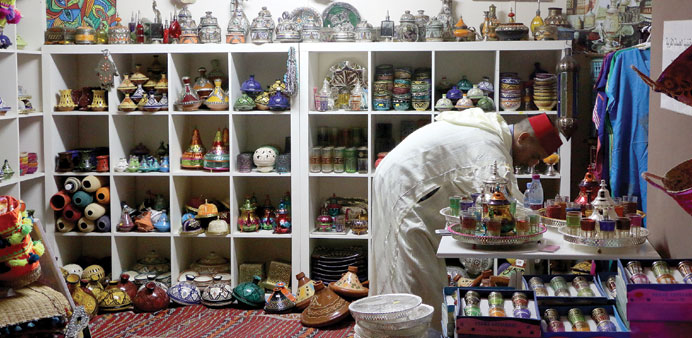By Umer Nangiana
From the ‘city of a thousand faces,’ the hidden treasures of art and craft — rooted in the rich past and tradition — come to Katara Cultural Complex this year. Marrakech, one of the oldest cities in North Africa, is known for its handicraft.
Marrakech, besides other major cities of Morocco, is steeped in tradition imported from East or the Muslim Spain. Eastern influence are visible particularly in carpets, fabrics and embroidery while the Andalusian capital is still perceived in the arts of ceramics, metal, wood and leather.
Passing from one generation to the other, the process of creativity in craft has been continuously evolving. The rich cultural heritage is visible even in the adaptation to the needs of the contemporary times.
Yassin Mahfoud, a handicrafts dealer, has brought a variety of traditional handmade crafts from all over Morocco. Carrying modern design and style, the pieces of art showcase the signature ‘Maghrebi’ tradition.
“These are all handmade and I have bought them from different places in Morocco. Every area has its own specialty,” Mahfoud said, holding a traditional Moroccan coffee set in his hand.
Handicrafts in Morocco are one of the fundamental characteristics of the Moroccan daily life. Mahfoud says he has different artefacts for sale besides items of daily utility like shoes and clothes, all handmade from different materials such as wood, metal, copper, wool, stone and clay.
He has bags in hand, loaded with accessories, and clay pots covered with leather belts. “Most of these items are made at home by women. Housewives would use the materials such as locally produced copper and other metals to produce candlesticks, appliques, framework for mirrors and other such items for decoration,” said the Moroccan merchant.
The woodwork is considered a fine art in Marrakech which requires great care and patience. The woodwork is possible thanks to the presence of trees such as cedar, pine, beech and olive. Morocco is home to several trees, particularly in valleys and mountains.
The carved items with Mahfoud have been transformed into true masterpieces by the hands of the artisans. In addition to their captivating beauty, these wood items also have a pleasant scent.
Small boxes, chest, tables on foot pads, chessboards are made of cedar wood decorated with ebony wood and lemon. Fez and Tetuan, the two cities, specialise in painting on wood called Zouak, said Mafhoud. Fez and Meknes are known by their moucharabieh, work of great finesse where small pieces of wood are assembled forming geometric compositions, he added. Clay of very good quality is worked until the impurities are completely removed and it is then shaped into vases, jars, pots, plates and trays. The finished product in Mafhoud’s hands look mesmerising.
These pots are usually embellished by hues typical of the region and geometric or floral decorations. The most famous cities for clay work are Fez, Safi, Sale and Marrakech.
Another craft from Morocco known for its beauty is embroidery. The dark blue embroidery of Fes and Marrakech are the most common and that of Rabat, Azemmour and Tetouan are also widespread. Executed with great skill using mostly the silk of different colours, the artisans make embroidered clothes in the form of tablecloths, napkins, Kaftan besides the Moroccan evening dress, said Mafhoud, pointing at one such dress in his shop in the Katara Ramadan Souq.
He is staying here till Eid, after which he will go back to bring more stuff from Morocco. Mafhoud said the business in Katara was really good and that he has been constantly kept busy in his shop, tending to westerners and Qataris, who form the bulk of his customers.
Pottery is one of the first crafts of the city of Marrakesh. And the Moroccan merchant has a lot to offer from the traditional rural and urban tradition of Moroccon pottery, bringing the best from the cities of Marrackech, Fez and Rabat.

HANDICRAFTS: Mafhoud has collected traditional Moroccan handicrafts from different cities. Photos by Umer Nangiana


